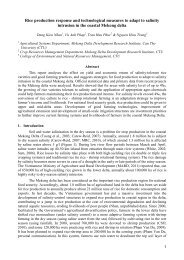start-with-the-park
Create successful ePaper yourself
Turn your PDF publications into a flip-book with our unique Google optimized e-Paper software.
Planning green infrastructure<br />
37<br />
Government policy<br />
Sustainable communities:<br />
building for <strong>the</strong> future<br />
Creating sustainable communities:<br />
Greening <strong>the</strong> Gateway<br />
A greenspace strategy for Thames Gateway<br />
ODPM has published a range<br />
of documents focused on <strong>the</strong><br />
delivery of prosperous, inclusive<br />
and sustainable communities for<br />
<strong>the</strong> 21st century, places where<br />
people want to live, that promote<br />
opportunity and a better quality<br />
of life for all<br />
The government’s 2003 sustainable<br />
communities plan 1 identifies two key<br />
challenges: stabilising and reversing<br />
social and economic decline in<br />
communities that are experiencing<br />
low demand for housing; and<br />
creating successful and sustainable<br />
neighbourhoods in areas of high demand<br />
and population growth. The document<br />
sets out a long-term programme<br />
of action for delivering sustainable<br />
communities, including <strong>the</strong> aim of<br />
making neighbourhoods, towns and<br />
cities more liveable. It recognises <strong>the</strong><br />
importance of <strong>the</strong> wide range of<br />
different types of green space.<br />
In early 2005 ODPM published<br />
Sustainable communities: people,<br />
places, prosperity– a five-year plan<br />
focused on delivering sustainable<br />
communities. The plan reiterates <strong>the</strong><br />
ambition to sustain <strong>the</strong> improvements in<br />
<strong>the</strong> quality of <strong>park</strong>s and green spaces.<br />
ODPM and Home Office funding streams<br />
will be streamlined into <strong>the</strong> Safer and<br />
Stronger Communities Fund, worth £660<br />
million. The plan includes a series of o<strong>the</strong>r<br />
actions, including new powers for local<br />
authorities to improve management and<br />
extend more powers to local people.<br />
ODPM’s Creating sustainable<br />
communities: greening <strong>the</strong> gateway<br />
(2004) 11 describes <strong>the</strong> need for a network<br />
of green infrastructure as <strong>the</strong> basis of<br />
successful and sustainable development<br />
in <strong>the</strong> Thames Gateway. Its non-statutory<br />
companion implementation plan 12 (2005)<br />
sets out <strong>the</strong> delivery framework, clarifying<br />
<strong>the</strong> roles of different partners and<br />
explaining where <strong>the</strong> funding will<br />
come from.<br />
The primary planning policy relating to<br />
green space is planning policy guidance<br />
17 (PPG17). 13 PPG17 aims to deliver<br />
networks of accessible, high-quality open<br />
spaces and sport and recreation facilities<br />
<strong>with</strong> an appropriate balance between<br />
providing new spaces and enhancing<br />
existing provision. The o<strong>the</strong>r main policy<br />
and guidance documents are noted in<br />
<strong>the</strong> appendix.<br />
PPG17 encourages planners to<br />
consider a wide range of types of<br />
open space. These include:<br />
• Parks and gardens<br />
• Natural and semi-natural urban<br />
green spaces<br />
• Green corridors<br />
• Outdoor sports facilities (<strong>with</strong><br />
natural or artificial surfaces)<br />
• Amenity green space (mostly in<br />
housing areas)<br />
• Productive urban green spaces<br />
• Burial sites<br />
• Green urban/rural fringe<br />
• Civic space.





